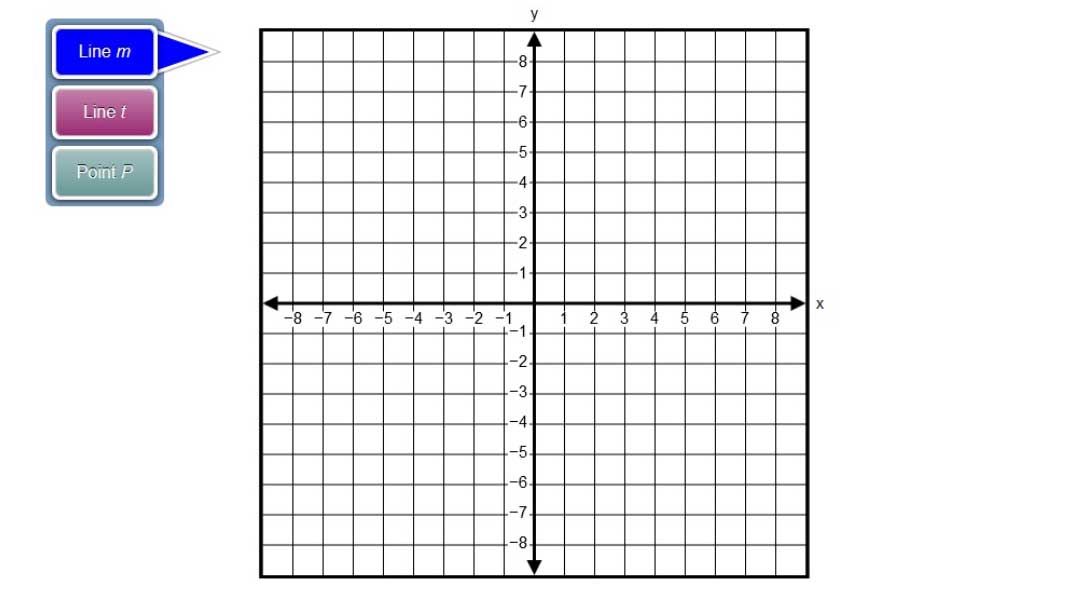
The following technology-enabled question, explained here in hopes of helping algebra students in Maryland and Illinois prepare for the PARCC test near the end of this school year, appears on the released version of PARCC’s Spring 2015 test in algebra 1, here:
Graph lines m and t on the xy-coordinate plane shown. Then plot the point of intersection, P.
- Line m:
- Line t:
To graph a line, select two points on the coordinate plane. A line will be drawn through the points.
Select the place on the coordinate plane to plot the point.

Resources for further study
Purple Math, developed by Elizabeth Stapel, a math teacher from the St Louis area, has a series of seven webpages that describe how to determine the solution to a system of two linear equations in two unknowns, given the equations and a way to plot the lines on a coordinate plane. The series starts here.
The Khan Academy, developed by Sal Khan, an engineer who has created a library of thousands of video lessons, has a six-part series about solving systems of linear equations, the first video in the series being entitled “Solving Linear Systems by Graphing.” It starts here.
Chapter 3, Section 3.1, of the book Algebra 2, Illinois edition by Ron Larson et al deals with solving systems of linear equations, with a nice development of how to solve (and understand) systems by graphing. The authors point out that a system of linear equations has infinitely many solutions when the two lines coincide, no solutions when the two lines are parallel, and exactly one solution in all other cases.
Complete reference: Ron Larson, Laurie Boswell, Timothy D Kanold, Lee Stiff. Algebra 2, Illinois edition. Evanston, Ill.: McDougal Littell, a division of Houghton Mifflin Company, 2008. The book is used in several algebra classes taught in Illinois high schools.
Analysis of this question and online accessibility
The question weakly measures knowledge of the Common Core standard it purports to measure and tests students’ ability to plot lines given the slope-intercept form of the equation for the line and to estimate the point of intersection of two non-parallel, non-coincident lines by graphing. The eighth-grade standard is a prerequisite, and the use of technology is incorporated from the math practices cited. The problem is considered to have a low cognitive demand.
Once the two lines are plotted, the student is told that Point P is at the intersection of the lines. If the student knows what the word “intersection” means, the question does not assess his or her understanding of the underlying mathematics of solving a system of linear equations by graphing. This is why the question is aligned to the eighth-grade standard, not to the high school algebra standard.
The question can be tested online and should yield results that are as valid and reliable as those obtained on paper. However, the use of the tool provided by PARCC may limit students’ ability to find a solution if they are unfamiliar with the tool. It requires students to select points on a coordinate grid with a pointing device, such as a computer mouse, and then drag the two points around to obtain the desired line. If students are unfamiliar with how this tool works on the PARCC test, their ability to achieve full credit for this question could be compromised.
The Maryland and Illinois governments have passed laws giving the respective state boards of education the responsibility of adopting standards of learning for students. Good or bad, both states have adopted customized versions of the Common Core, which, in math, incorporates what are known as “math principles.” The principles, printed on the top of a $90 8-foot-wide wall chart I have in my room with the standards on it, are considered overarching. In spirit, then, no one tool is endorsed (see Math Practice 5, e.g., above), but students are expected to be creative and use whatever tool they feel is appropriate to solve a given math problem. This question forces students to use a specific technology tool to solve the problem and, as such, violates the Common Core’s prevailing math principles, which both states have duly adopted by willful action of the appropriate governing bodies.
(The use of technology to estimate a solution is an artifact of PARCC and results from the consortium’s interpretation of and self-imposed restrictions on what the Common Core math practices refer to as the use of technology. This artificial limitation imposed by the test penalizes creative students, who are unable to decide for themselves which “technology” is most appropriate, as stated in the Common Core. The question, as delivered online, does not align to several key aspects of the Common Core and is therefore invalid.)
No special accommodation challenges can be identified with this question, so the question is considered fair. However, if the item is delivered on paper, severe motor difficulties would present a challenge for students and would have to be accommodated. It’s possible, since human scoring would be required for paper delivery, that the item is not available on the paper version of the test.
Challenge
Given current prices and expected time of ownership, it costs about 5.5 cents per mile to operate a diesel car and about 13 cents per mile to operate a car that runs on gasoline. (Gasoline cars also require more tune-ups.)
Diesel cars are also a bit more expensive than their gasoline-running counterparts. Assume a diesel car would cost you about $3,500 more to purchase than a gasoline car.
If d(m) is a function that defines the cost of running a diesel car m miles after your initial purchase and g(m) is a function that defines the cost of running a gasoline car m miles after your initial (less expensive) purchase, how many miles would you drive before you break even?
Purpose of this series of posts
Voxitatis is developing blog posts that address every algebra 1 question released to the public by the Partnership for Assessment of Readiness for College and Careers, or PARCC, in order to help students prepare to take the test this spring.
Our total release will run from February 27 through March 15, with one or two questions discussed per day. Then we’ll move to geometry at the end of March, algebra 2 during the first half of April, and eighth grade during the last half of April.
















